Circle Theorems on Arcs

A part of the circumference of a circle is called an arc. In the figure, ACB is a part of the circumference of the circle with centre O. So, ACB is called an arc.
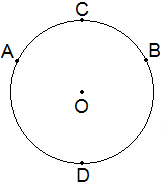
So, arc ACB is a minor arc and arc ADB is a major arc.
THEOREM 4:
“Arcs subtended by
equal angles at the centre of the circle are equal.”
This theorem can be verified by an experiment. Here is the
experimental verification of the theorem:
Experimental
Verification:
Construction: By using a pencil and compass, two circles of different radii with centre at ‘O’ are drawn. In each figure, with the help of a protractor two equal angles POQ and ROS at the centre are drawn.
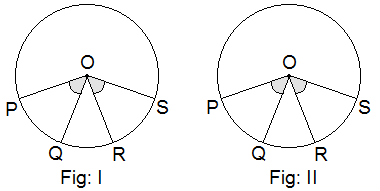
With the help of a thread, arcs PQ and RS of each figure are
measured and the results are tabulated below:
Table:

Conclusion: The above experiment shows that arcs subtended by equal angles
at the centre of the circle are equal.
CONVERSE OF THEOREM 4:
“Angles subtended by
two equal arcs of a circle at the centre are equal.”
This converse theorem also can be verified by an experiment.
Here is the experimental verification of the theorem:
Experimental Verification:
Construction: By using a pencil and compass, two circles of different radii with centre at ‘O’ are drawn. With the help of compass two equal arcs XY and MN in each figure are drawn. Points X, Y, M, and N are joined with the centre O.
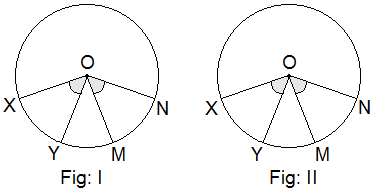
With the help of a protractor, central angles XOY and MON of
each figure are measured and the results are tabulated below:
Table:

Conclusion: The above experiment shows that the angles subtended by equal arcs
at the centre of the circle are equal.
THEOREM 5:
“Arcs cut off by equal
chords of a circle are equal. Or, If two chords of a circle are equal, the
corresponding arcs are equal.”
This theorem can be verified by an experiment. Here is the
experimental verification of the theorem:
Experimental Verification:
Construction: By using a compass and pencil, two circles of different radii with centre O are drawn. In each figure, two equal chords JK and MN are drawn.

With the help of a thread, arcs JK and MN are measured in each
circle and the results are tabulated below:
Table:

Conclusion: The above experiment shows that if two chords of a circle are equal, the corresponding arcs are equal.
CONVERSE OF THEOREM 5:
“If two arcs of a
circle are equal, the corresponding chords are equal.”
This theorem can be verified by an experiment. Here is the
experimental verification of the theorem:
Experimental Verification:
Construction: By using a compass and pencil, two circles of different radii with centre O are drawn. In each figure, arc AB = arc CD are also drawn. Then the chords AB and CD are drawn.
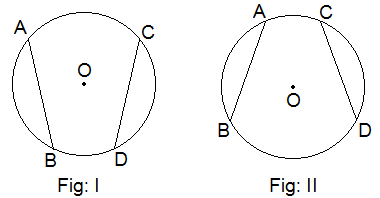
With the help of a divider and a scale, chords AB and CD are
measured and the results are tabulated below:
Table:

Conclusion: The above experiment shows that if two arcs of a circle are
equal, the corresponding chords are equal.
THEOREM 6:
“The angle at the
centre of a circle is double the angle at the circumference standing on the same
arc.”
This theorem can be verified experimentally as well as
theoretically.
Experimental Verification:
Construction: By using a compass and pencil, two circles of different radii with centre O are drawn. In each figure, ∠AOB at the centre and ∠ACB at the circumference standing on the same arc AB are drawn.

With the help of a protractor, ∠AOB and ∠ACB of each figure are measured and the results are tabulated
below:
Table:

Conclusion: The above experiment shows that the angle at the centre of a circle
is double the angle at the circumference standing on the same arc.
Theoretical Proof:
Given: O is the centre of the circle. Central angle ∠AOB and the circumference angle ∠ACB are
standing on the same arc ADB.
To Prove: ∠AOB = 2∠ACB

Proof:
Statements Reasons
1. ∠AOB = arc ADB ----> Central angle is equal to the opposite arc.
2. ∠ACB = ½ arc ADB ----> Circumference angle is half of opposite
arc.
Or, 2∠ACB = arc ADB
3. ∠AOB = 2∠ACB -----> From
statements 1 and 2.
Proved.
THEOREM 7:
“The angle in a
semi-circle is a right angle.”
This theorem can be verified experimentally as well as
theoretically.
Experimental Verification:
Construction: By using a compass and pencil, two circles of different radii
with centre O are drawn. In each figure, diameter AB and ∠ACB are drawn.
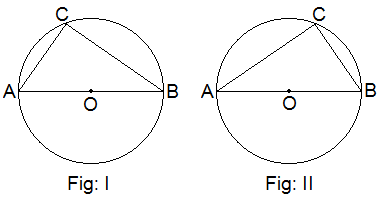
With the help of a protractor, ∠ACB of
each figure is measured and the results are tabulated below:
Table:

Conclusion: The above experiment shows that the angle in a semi-circle is a
right angle.
Theoretical Proof:
Given: ACB is an angle in the semi-circle with centre at O and
diameter AB.
To Prove: ∠ACB = 90°
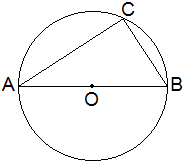
Proof:
Statements Reasons
4. ∠ACB = ½ ∠AOB ----> Circumference
angle is half of central angle.
5. ∠AOB = 180° ----> Circumference angle is half of opposite arc.
6. ∠ACB = ½ × 180° -----> From statements 1 and 2.
Or, ∠ACB = 90°
Proved.
THEOREM 8:
“The angles at the
circumference of a circle standing on the same arc are equal. OR, Angles in the
same segment of a circle are equal.”
This theorem can be verified experimentally as well as
theoretically.
Experimental Verification:
Construction: By using a compass and pencil, two circles of different radii
with centre O are drawn. In each figure, circumference angles ∠ACB and ∠ADB standing on the same arc
AB are drawn.
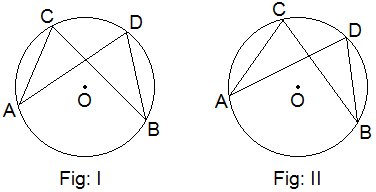
With the help of a protractor, ∠ACB and ∠ADB of each figure are measured and the results are tabulated
below:
Table:

Conclusion: The above experiment shows that the circumference angles
standing on the same arc or segment are equal.
Theoretical Proof:
Given: O is the centre of the circle. ∠ACD and ∠ABD are inscribed angles on the same arc AD.
To Prove: ∠ACB = ∠ABD
Construction: A and D are joined with O.

Proof:
Statements Reasons
1.
∠ACD = ½ ∠AOD -----> Inscribed angle is half of central angle.
2.
∠ABD = ½ ∠AOD -----> Inscribed angle is half of central angle.
3.
∠ACD = ∠ABD -----> From statements 1 and 2.
Proved.
THEOREM 9:
“The opposite angles
of a cyclic quadrilateral are supplementary. OR, Angles in opposite segments of
a circle are supplementary.”
This theorem can be verified experimentally as well as
theoretically.
Experimental Verification:
Construction: By using a compass, scale and pencil, two circles of different
radii with centre O are drawn. In each figure, cyclic quadrilateral ABCD are
drawn.

With the help of a protractor, ∠A, ∠B, ∠C and ∠D are measured and the results are tabulated below:
Table:

Conclusion: The above experiment shows that the opposite angles of a cyclic
quadrilateral are supplementary.
Theoretical Proof:
Given: O is the centre of the circle. PQRS is a cyclic quadrilateral.
To Prove: (i) ∠P + ∠R = 180° (ii) ∠Q + ∠S = 180°

Proof:
Statements Reasons
1.
∠P = ½ arc QRS ---->
Inscribed angle is half of opposite arc.
2.
∠R = ½ arc QPS ----> Inscribed angle is half of opposite
arc.
3.
∠P + ∠R = ½ (arc QRS + arc QPS) -----> Adding 1 and 2.
= ½ circle PQRS
= ½ × 360°
= 180°
4.
∠Q + ∠S = 180° ------> Same as above.






Post a Comment
0 Comments